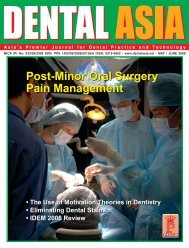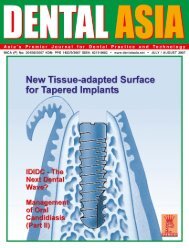Human Resource Management - Its Impact on ... - Dental Asia
Human Resource Management - Its Impact on ... - Dental Asia
Human Resource Management - Its Impact on ... - Dental Asia
- No tags were found...
You also want an ePaper? Increase the reach of your titles
YUMPU automatically turns print PDFs into web optimized ePapers that Google loves.
USERREPORTWe have already noted two factors. But micromovement andmicrogaps are not the <strong>on</strong>ly enemies of stable tissue. Possiblenegative effects of the implant-abutment transiti<strong>on</strong> are alsoreduced by moving this c<strong>on</strong>necti<strong>on</strong> away from the peri-implanttissue to prevent any irritati<strong>on</strong>. This is d<strong>on</strong>e by displacing theimplant-abutment c<strong>on</strong>necti<strong>on</strong> to the center by using anabutment with a smaller diameter than that of the implant. Thisdisplaces the biological width from the vertical to the horiz<strong>on</strong>talplane. This procedure is referred to as platform switching.Platform switching is an important factor in tissue stability – but<strong>on</strong>ly in combinati<strong>on</strong> with a c<strong>on</strong>necti<strong>on</strong> design that preventsmicromovement and is bacteria-proof, which we call platformshifting ® .Figure 1 (left) X-ray image of the Ankylos implant-abutment c<strong>on</strong>necti<strong>on</strong>before starting the test (x-ray image: Holger Zipprich/Dr. Paul Weigl,Frankfurt am Main/Germany)Figure 2 (right) X-ray image of the Ankylos implant-abutment c<strong>on</strong>necti<strong>on</strong>after 1,000,000 load cycles (x-ray image: Holger Zipprich/Dr. Paul Weigl,Frankfurt am Main/Germany)A bacteria-proof fricti<strong>on</strong>-locked and keyedc<strong>on</strong>necti<strong>on</strong> is <strong>on</strong>ly possible with the taperedc<strong>on</strong>necti<strong>on</strong> completely flushinterface level. Theb<strong>on</strong>e resp<strong>on</strong>ds withresorpti<strong>on</strong> below theimplant-abutmentc<strong>on</strong>necti<strong>on</strong> until thebiological width hasbecome established.The potential forinfecti<strong>on</strong> is reducedwithout the microgap– and in combinati<strong>on</strong>with no micromovementit iscompletelyeliminated. Withoutmicrobial leakage ofthe implant lumenthere is no microbialcol<strong>on</strong>izati<strong>on</strong> andwithout endotoxinsno potential forinfecti<strong>on</strong>. For these reas<strong>on</strong>s when dealing with cases with lowb<strong>on</strong>e volume, thin gingiva or particularly high esthetic demandsthe implantologist must look for c<strong>on</strong>necti<strong>on</strong> that is as bacteriaproofas possible and with as little gap as possible whenselecting the implant system. This will keep the hard and softtissue stable.The smaller abutment also provides more space for periimplantsoft tissue and as a result improves the red esthetics.However, red esthetics al<strong>on</strong>e is generally not sufficient,particularly for the esthetically sensitive fr<strong>on</strong>t-tooth regi<strong>on</strong>.This is the area where the patient wants perfect whiteesthetics, a tooth that appears as if nothing had everhappened. The emergence profile is the key in this case. Theformati<strong>on</strong> of a natural emergence profile often requiredsubcrestal placement of the implant to take full advantage ofplatform shifting. However, for implants with a c<strong>on</strong>necti<strong>on</strong> thatallows micro-movements and a microgap this is a real“implant killer.”The b<strong>on</strong>e will remain stable in spite of subcrestal placement ofthe implant <strong>on</strong>ly if there is absolutely no irritati<strong>on</strong>, which meansa bacteria-proof and rigid c<strong>on</strong>necti<strong>on</strong> design that alsoeliminates irritati<strong>on</strong> by using platform switching. This results ina natural emergence profile that also leaves additi<strong>on</strong>al spacefor stable, thick soft tissue over the implant shoulder. It is clearthat this is not required in every case.Even if there are implant systems that can be placedsubcrestally, b<strong>on</strong>e depositi<strong>on</strong> above the c<strong>on</strong>necti<strong>on</strong> level wasformerly not c<strong>on</strong>sidered feasible because the microroughnessof the implant surface always ended below the implantshoulder. Implant c<strong>on</strong>cepts that make use of tissue depositi<strong>on</strong>in the shoulder regi<strong>on</strong> of the implant simply extend thegrowth-activating implant surface over the shoulder regi<strong>on</strong>of the implant.What happens then is dem<strong>on</strong>strated by the most recentstudies. B<strong>on</strong>e and c<strong>on</strong>nective tissue cells adhere to and spreadfaster and more extensively <strong>on</strong> a microroughened implantshoulder than <strong>on</strong> a machined surface. In combinati<strong>on</strong> withplatform switching, subcrestal placement and a c<strong>on</strong>necti<strong>on</strong>design that eliminates micromovements b<strong>on</strong>e can even grow<strong>on</strong> the horiz<strong>on</strong>tal shoulder surface and <strong>on</strong> the abutment. Thissupports the overlying soft tissue and gives patients l<strong>on</strong>gtermstability of esthetic results.Analytical • Authoritative • AcclaimedFor more informati<strong>on</strong>, email: info@pabloasia.com<strong>Dental</strong> <strong>Asia</strong> • March / April 200841





